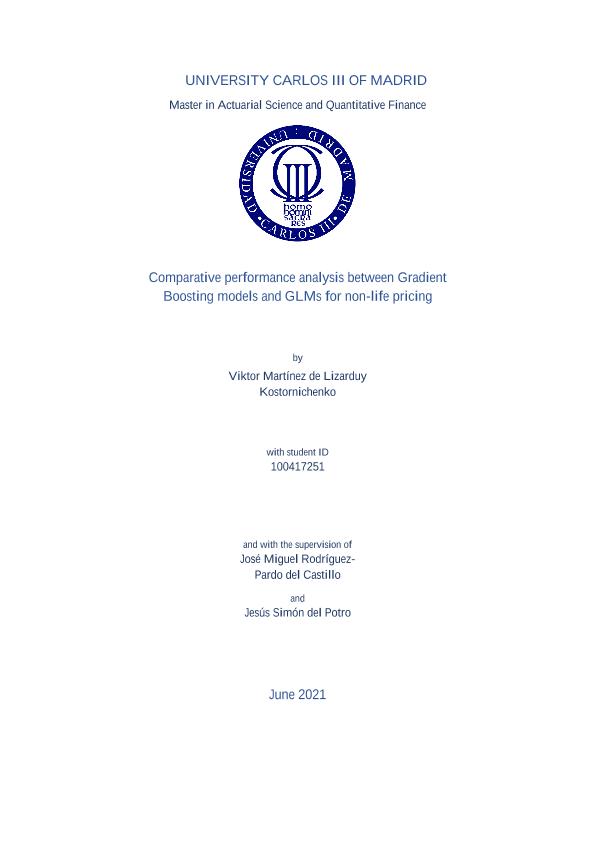| LDR | | | 00000cam a22000004b 4500 |
| 001 | | | MAP20210035753 |
| 003 | | | MAP |
| 005 | | | 20220911185740.0 |
| 008 | | | 211217s2021 esp|||| ||| ||eng d |
| 040 | | | $aMAP$bspa$dMAP |
| 084 | | | $a6 |
| 100 | 1 | | $0MAPA20210037092$aMartínez de Lizarduy Kostornichenko, Viktor |
| 245 | 1 | 0 | $aComparative performance analysis between Gradient Boosting models and GLMs for non-life pricing$cViktor Martínez de Lizarduy Kostornichenko |
| 260 | | | $aMadrid$bUniversidad Carlos III de Madrid$c2021 |
| 300 | | | $a118 p. |
| 505 | 0 | | $aTrabajo Fin de Master del Master en Ciencias Actuariales y Financieras de la Escuela de Postgrado de la Universidad Carlos III de Madrid. Tutores: José Miguel Rodríguez-Pardo del Castillo, Jesús Simón del Potro Curso 2020-2021 |
| 520 | | | $aModelling the behavior of risks is one of the most fundamental pillars in the insurance business throughout all its branches. Actuarial practitioners have always been interested in finding the best statistical tools to capture the nature of the risks they undertake from their clients, and in the last decades these techniques have thrived through the implementation and expansion of Machine Learning, both to process and handle large amounts of data, as well as to carry out advanced computations. Specifically, and as the purpose of this document, we will be focusing on the Gradient Boosting algorithms from the sub-family of ensemble methods used for regression to predict and model basic pricing variables such as frequency and claim severities, and compare their predictive and pricing capabilities with classical Generalized Linear Models. In our study case of a French insurance motor portfolio, we found that Gradient Boosting models have a stronger predictive performance and a higher pricing ability to adjust the premiums to both high risk and low risk profiles. And finally, we conclude that these models can be used to support and improve GLMs and their pricing results as Machine Learning continues to settle in the actuarial modeling paradigm. |
| 650 | | 4 | $0MAPA20080592011$aModelos actuariales |
| 650 | | 4 | $0MAPA20080588953$aAnálisis de riesgos |
| 650 | | 4 | $0MAPA20080592059$aModelos predictivos |
| 650 | | 4 | $0MAPA20080604127$aTarificación a priori |
| 650 | | 4 | $0MAPA20170005476$aMachine learning |
| 650 | | 4 | $0MAPA20080573935$aSeguros no vida |
| 650 | | 4 | $0MAPA20080594589$aAnálisis comparativo |
| 650 | | 4 | $0MAPA20160001693$aModelos GLM |
| 650 | | 4 | $0MAPA20210037177$aModelos GBM |
| 650 | | 4 | $0MAPA20080664510$aTrabajos de investigación |
| 700 | 1 | | $0MAPA20140014897$aRodríguez-Pardo del Castillo, José Miguel |
| 700 | 1 | | $0MAPA20160001525$aSimón del Potro, Jesús Ramón |
| 710 | 2 | | $0MAPA20080455026$aUniversidad Carlos III de Madrid |
| 830 | | 0 | $0MAPA20160014013$aTrabajos Fin de Master |
| 856 | | | $qapplication/pdf$w1113083$yRecurso electrónico / Electronic resource |


